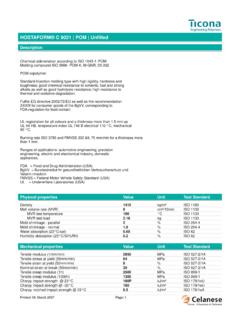Transcription of CELCON® M90™ | POM | Unfilled
1 CELCON M90 | POM | UnfilledTicona - A business of CelanesePage: 1 Printed: 08. January 2007 DescriptionCelcon acetal copolymer grade M90 is a medium viscosity polymer providing optimum performance in general purposeinjection molding and extrusion of thin walled tubing and thin gauge film. This grade provides overall excellent performance inmany propertiesValueUnitTest StandardDensity1410kg/m ISO 1183 Melt volume rate (MVR)8cm /10minISO 1133 MVR test temperature190 CISO 1133 MVR test 1133 Mold shrinkage - parallel2%ISO 294-4 Mold shrinkage - 294-4 Water absorption (23 C-sat) 62 Humidity absorption (23 C/50%RH) 62 Mechanical propertiesValueUnitTest StandardTensile modulus (1mm/min)2760 MPaISO 527-2/1 ATensile stress at yield (50mm/min)66 MPaISO 527-2/1 ATensile strain at yield (50mm/min)10%ISO 527-2/1 ATensile creep modulus (1h)
2 2450 MPaISO 899-1 Tensile creep modulus (1000h)1350 MPaISO 899-1 Flexural modulus (23 C)2550 MPaISO 178 Charpy impact strength @ 23 ISO 179/1eUCharpy impact strength @ -30 ISO 179/1eUCharpy notched impact strength @ 23 ISO 179/1eACharpy notched impact strength @ -30 ISO 179/1eANotched impact strength (Izod) @ 23 ISO 180/1 AThermal propertiesValueUnitTest StandardMelting temperature (10 C/min)165 CISO 11357-1,-2,-3 DTUL @ MPa101 CISO 75-1/-2 Vicat softening temperature B50 (50 C/h 50N)161 CISO linear therm. expansion (parallel) CISO linear therm. expansion (normal) CISO 11359-2 Electrical propertiesValueUnitTest StandardVolume resistivity8E12 Ohm*mIEC 60093 Surface resistivity3E16 OhmIEC 60093 Test specimen productionValueUnitTest StandardProcessing conditions acc.
3 ISO9988-2-InternalInjection molding melt temperature205 CISO 294 Injection molding mold temperature90 CISO 294 Injection molding flow front velocity200mm/sISO 294 Injection molding hold pressure86 MPaISO 294 CELCON M90 | POM | UnfilledTicona - A business of CelanesePage: 2 Printed: 08. January 2007 Rheological Calculation propertiesValueUnitTest StandardDensity of melt1200kg/m InternalThermal conductivity of (m K)InternalSpecific heat capacity of melt2210J/(kg K)InternalEff. thermal /sInternalEjection temperature165 CInternalStress-strainSecant modulus-strainCELCON M90 | POM | UnfilledTicona - A business of CelanesePage: 3 Printed: 08.
4 January 2007 Stress-strain (isochronous)Creep modulus-timeStress-strain (isochronous)Creep modulus-timeCELCON M90 | POM | UnfilledTicona - A business of CelanesePage: 4 Printed: 08. January 2007 Typical injection moulding processing conditionsMaximum residual moisture content: %Processing Temperatures: CavityMeltHot RunnerDie4321 FeedingHoppermin ( C)77182N/AN/AN/AN/AN/AN/AN/AN/Amax ( C)93199N/A198193188182176N/AN/AProcessin g Pressures: Injection PressureHolding PressureBack Pressuremin (bar)6006000max (bar)120012005 Injection speed: Screw speed:Screw diameter (mm)254055 Screw speed (rpm)15010070 Pre-drying conditions:Drying is not normally required.
5 If material has come in contact with moisture through improper storage or handling orthrough regrind use, drying may be necessary to prevent splay and odor time: 3 hDrying temperature: 80 - 100 CSpecial information:No special information MoldingStandard reciprocating screw injection molding machines with a high compression screw (minimum 3:1 and preferably 4:1)and low back pressure ( Mpa/50 PSI) are favored. Using a low compression screw ( general purpose 2:1 compressionratio) can result in unmelted particles and poor melt homogeneity. Using a high back pressure to make up for a lowcompression ratio may lead to excessive shear heating and deterioration of the M90 | POM | UnfilledTicona - A business of CelanesePage: 5 Printed: 08.
6 January 2007 Melt Temperature: Preferred range 182-199 C (360-390 F). Melt temperature should never exceed 230 C (450 F).Mold Surface Temperature: Preferred range 82-93 C (180-200 F) especially with wall thickness less than mm ( in.).May require mold temperature as high as 120 C (250 F) to reproduce mold surface or to assure minimal molded in thickness greater than 3mm (1/8 in.) may use a cooler (65 C/150 F) mold surface temperature and wall thickness over6mm (1/4 in.) may use a cold mold surface down to 25 C (80 F). In general, mold surface temperatures lower than 82 C (180F) may produce a hazy surface or a surface with flow lines, pits and other included ExtrusionStandard extruders with a length to diameter ratio of at least 20:1 are recommended.
7 The screw should be a highcompression ratio of at least 3:1 and preferably 4:1 to assure good melting and melt homogeneity. The design should beapproximately 35% each for feed and metering sections with the remaining 30% as the transition temperature: 160-220 C (320-430 F)Other ExtrusionStandard extruders with a length to diameter ratio of at least 20:1 are recommended. The screw should be a highcompression ratio of at least 3:1 and preferably 4:1 to assure good melting and uniform melt homogeneity. The design shouldbe approximately 35% each for the feed and metering sections with the remaining 30% as transition zone.
8 Melt temperature 180-230 C (355-450F)Profile ExtrusionStandard extruders with a length to diameter ratio of at least 20:1 are recommended. The screw should be a highcompression ratio of at least 3:1 and preferably 4:1 to assure good melting and melt homogeneity. The design should beapproximately 35% each for feed and metering sections with the remaining 30% as the transition temperature: 180-230 C (360-450 F).Sheet ExtrusionStandard extruders with a length to diameter ratio of at least 20:1 are recommended. The screw should be a highcompression ratio (at least 3:1 and preferably 4:1) to assure good melting and uniform melt homogeneity.
9 The screw designshould be approximately 35% each for the feed and metering sections with the remaining 30% as the transition temperature 180-190 C (355-375 F).Blow MoldingConsult product information product information MoldingConsult product information InformationAmericasTiconaProduct Information Service8040 Dixie HighwayFlorence, KY 41042 USATel.: +1-800-833-4882 EuropeTicona GmbHInformation ServiceTel.: +49 (0) 180-5842662 (Germany)*+49 (0) 69-30516299 (Europe)Fax: +49 (0) 180-2021202 (Germany & Europe)**email: M90 | POM | UnfilledTicona - A business of CelanesePage: 6 Printed: 08.
10 January 2007 Tel.: +1-859-372-3244email: on the web: ServiceTel.: +1-800-526-4960 Tel.: +1-859-372-3214 Fax: +1-859-372-3125 Internet: *starting 0,14 /minute + local landline rates**0,06 /Call + local landline ratesGeneral DisclaimerNOTICE TO USERS: Values shown are based on testing of laboratory test specimens and represent data that fall within the standard rangeof properties for natural material. These values alone do not represent a sufficient basis for any part design and are not intended for use inestablishing maximum, minimum, or ranges of values for specification purposes.
